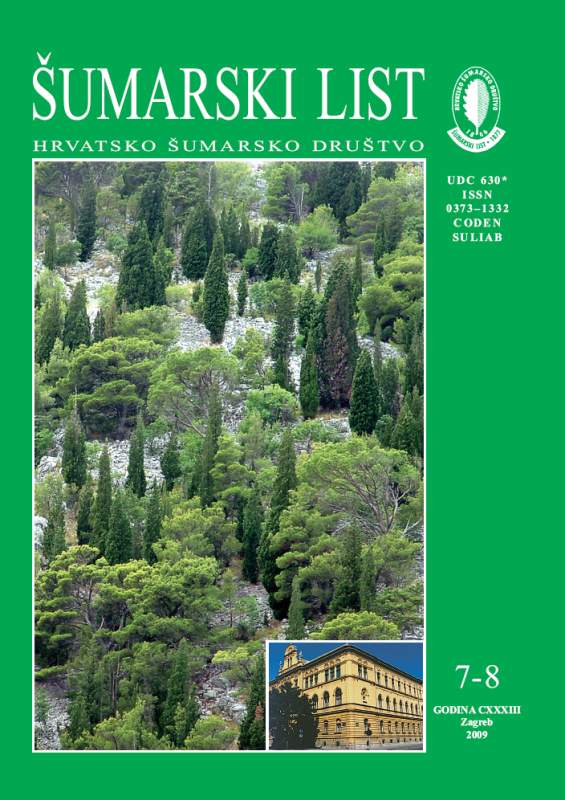
broj: 7-8/2009
pdf (8,4 MB) |
|
||||||||||||||
| RIJEČ GLAVNOGA UREDNIKA | ||
| Branimir Prpić | ||
| MORE ABOUT FORESTS AND NATURE PROTECTIONIN RELATION TO NATURA 2000 IN CROATIA pdf HR EN | 368 | |
| IZVORNI ZNANSTVENI ČLANCI | ||
| Vedriš,M., A.Jazbec, M.Frntić, M.Božić, E.Goršić | UDK 630* 529 (001) | |
| Precision of Structure Elements’ Estimation in a Beech – Fir Stand Depending on Circular Sample Plot Size pdf HR EN | 369 | |
| Matošević,D., M.Pernek, T.Dubravac, B.Barić | UDK 630* 453 (001) | |
| Research of Leafminers onWoody Plants in Croatia pdf HR EN | 381 | |
| Dubravac,T., S.Dekanić | UDK 630* 423 (001) | |
| Structure and Dynamics of the Harvest of Dead and Declining Trees of Pedunculate Oak in the Stands of Spačva Forest from 1996 to 2006 pdf HR EN | 391 | |
| Summary: From the literature sources and observations from the field forestry experts, two major assumptions regarding the relationship between the pedunculate oak dieback and the stand´s age and phytocoenological community emerge: (1) middle-aged, older and old stands are most susceptible to oak dieback and decline, and (2)highest intensity of oak dieback and decline occurs in the stands of pedunculate oak in microtopographically lowest positions – microdepressions. In the current contribution, we investigate two afforementioned statements in the pedunculate oak stands from first to sixth age class in the Spačva forest complex. As an indicator of the susceptibility of the stands to oak dieback and decline we used dynamics and structure of the harvest of the dead and declining oaks in the period of 11 years (1996– 2006). Analysis is based on the available data regularily gathered during the forest management in the “Hrvatske šume” Ltd., and archived in the database HS Fond. From the acquired data, total of 962 subcompartments with total area of 20 671 ha were selected according to the set of criteria for the further analysis, and divided into three groups according to phytocoenolgical association (Table 2 and Table 3). In the selected subcompartments during the monitoring period in total 850 835 m3of pedunculate oak was harvested, out of which 58 % (492 583 m3) were dead and declining trees (Figure 9 and Figure 10). In more than 69 % of the subcompartments, harvest events were recorded three and more times, and in the 20 % almost every second year (five harvesting events) (Figure 8). With regard to stand age, intensity of the harvest of the dead and declining oaks increases steeply after the stand age of 80 years (Figure 11). However, further analysis showed great variability of the intensity within the same age class (Figure 12). Thus, it is impossible to arrive at the general conlcusion about the role of the stand age in the proces of oak decline, because stand age most likely only amplifies negative factors already present in the stand. There were no statisticaly significant differences in the total intensity of the harvest of dead and declining oaks (m3/ha) during the monitoring period between the stands of the different phytocoenological communities (Figure 14; Kruskal-Wallis test, n=891; H=3,825; p>0,05). Difference is more prouounced with regard to dynamics of harvesting intensity. In that sense it is confirmed that stands in the microdepresions are more unstable compared to the stands of the other two forest communities with highest (7,1 % in 1998) but also the lowest (1.8 % in 2000) recorded average yearly intensity of oak growing stock harvested trough dead and declining trees (Figure 13). Moreover, the consequences of the harvest of the dead and declining trees are more severe given the lack of the understory in the stands in the lowest microtopographical positions. Further research is needed to properly quantify those differences. Spatial database of the pedunculate oak stands in the Spačva forest that emerged as one of the results in this research will be continuously updated in the following years. Interconnection of this database with other spatialy explicit databases, e.g. measurements of groundwater levels, will enable more complex and in-depth spatiotemporal analysis of oak decline and dieback. Conclusions based on the results of this research relate to the pedunculate oak stands in the Spačva forest, and require verification for other larger oak complexes in Croatia with further application of the methodology outlined in this contribution. Key words: dieback; pedunculate oak; phytocoenological community; Spačva forest; stand age | ||
| Godina, K. | UDK 630* 569 (001) | |
| Development Structure Elements in Mixed Oak Stands in Aria of ForestAdministration Bjelovar with Retrospect on Modelling Growth andYield of Mixed Stands pdf HR EN | 407 | |
| Cerovečki, Z. | UDK 630* 188 (001) | |
| Beech Forests and Milava –As.Calamagrosti arundinaceae-Fagetum(Ht. 1950) Cerovečki ass. nov. of the Mountain of West Croatia pdf HR EN | 417 | |
| STRUČNI ČLANCI | ||
| Pašičko,R., D.Kajba, J.Domac | UDK 630* 425 (biomasa–Biomass) | |
| Impacts of EmissionTrading Markets on Competitiveness of Forestry Biomass in Croatia pdf HR EN | 425 | |
| Grgurević, D. | UDK 630* 272 (Cactaceae) | |
| Succulents (fat plants) on theAdriatic Coast and their Use in Parks pdf HR EN | 439 | |


